Communication diagram |
|
Similar to Sequence Diagram, the Communication Diagram is also used to model the dynamic behavior of the use case. When compare to Sequence Diagram, the Communication Diagram is more focused on showing the collaboration of objects rather than the time sequence. You don't need to create both diagrams manually because Visual Paradigm allows you to generate it from one to the other.
|
|
|
Use case diagram
|
Class diagram
|
Sequence diagram
|
Communication diagram
|
State machine diagram
|
Activity diagram
|
Component diagram
|
Deployment diagram
|
Package diagram
|
Object diagram
|
Composite structure diagram
|
Timing diagram
|
Interaction overview diagram
|
|
|
|
|
Communication diagram |
|
|
|
Notation
 | | Actor |  | | Call Message | |  | | Constraint |  | | Dependency | |  | | Destroy Message |  | | Generalization | |  | | LifeLine |  | | LifeLine <<Boundary>> | |  | | LifeLine <<Control>> |  | | LifeLine <<Entity>> | |  | | Link |  | | Message | |  | | Note |  | | Return Message | |  | | Send Message |  | | Sequence Message | |  | | Swimlane | |
| DefinitionSimilar to Sequence Diagram, the Communication Diagram is also used to model the dynamic behavior of the use case. When compare to Sequence Diagram, the Communication Diagram is more focused on showing the collaboration of objects rather than the time sequence. You don't need to create both diagrams manually because Visual Paradigm allows you to generate it from one to the other. |
|
| |
Actor | |  | | Definition | An Actor models a type of role played by an entity that interacts with the subject (e.g., by exchanging signals and data), but which is external to the subject (i.e., in the sense that an instance of an actor is not a part of the instance of its corresponding subject). Actors may represent roles played by human users, external hardware, or other subjects. Note that an actor does not necessarily represent a specific physical entity but merely a particular facet (i.e., "role") of some entity that is relevant to the specification of its associated use cases. Thus, a single physical instance may play the role of several different actors and, conversely, a given actor may be played by multiple different instances.
Since an actor is external to the subject, it is typically defined in the same classifier or package that incorporates the subject classifier |
| | Properties | | | Name | The name of actor. | | Documentation | Description of actor. | | Abstract | If true, the actor does not provide a complete declaration and can typically not be instantiated. An abstract actor is intended to be used by other actors. | | Leaf | Indicates whether it is possible to further specialize an actor. If the value is true, then it is not possible to further specialize the actor. | | Root | Indicates whether the actor has no ancestors. (true for no ancestors) | | Business model | Set it to make the actor become a "business actor" | | Attributes | Refers to all of the Properties that are direct (i.e., not inherited or imported) attributes of the actor. | | Operations | An operation is a behavioral feature of an actor that specifies the name, type, parameters, and constraints for invoking an associated behavior. Operations here refers to the operations owned by the actor. |
|
|
|
|
| |
Call Message | | 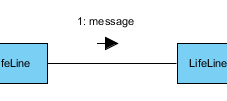 | | Definition | A message defines a particular communication between Lifelines of an Interaction.
Call message is a kind of message that represents an invocation of operation of target lifeline. |
| | Properties | | | Name | The name of message. | | Action Type | Type action type of the message. | | Return Value | The information to return to caller. | | Sequence No. | The number of message indicates the order of message within an interaction. | | Documentation | Description of message. | | Asynchronous | Determines whether the message is an asynchronous or a synchronous message. |
|
|
|
|
| |
Constraint | | 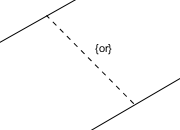 | | Definition | | A condition or restriction expressed in natural language text or in a machine readable language for the purpose of declaring some of the semantics of an element. |
| | Properties | | | Name | The name of constraint. It is optional and is commonly omitted. | | Expression | The condition that must be true when evaluated in order for the constraint to be satisfied. | | Documentation | Description of constraint. |
|
|
|
|
| |
Dependency | | 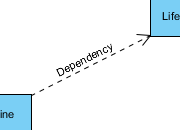 | | Definition | | A dependency is a relationship that signifies that a single or a set of model elements requires other model elements for their specification or implementation. This means that the complete semantics of the depending elements is either semantically or structurally dependent on the definition of the supplier element(s). |
| | Properties | | | Name | The name of dependency. | | Supplier | The element(s) independent of the client element(s), in the same respect and the same dependency relationship. In some directed dependency relationships (such as Refinement Abstractions), a common convention in the domain of class-based OO software is to put the more abstract element in this role. Despite this convention, users of UML may stipulate a sense of dependency suitable for their domain, which makes a more abstract element dependent on that which is more specific. | | Client | The element(s) dependent on the supplier element(s). In some cases (such as a Trace Abstraction) the assignment of direction (that is, the designation of the client element) is at the discretion of the modeler, and is a stipulation. | | Visibility | Determines where the dependency appears within different namespaces within the overall model, and its accessibility. | | Documentation | Description of dependency. |
|
|
|
|
| |
Destroy Message | | 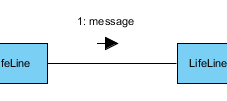 | | Definition | A message defines a particular communication between Lifelines of an Interaction.
Destroy message is a kind of message that represents the request of destroying the lifecycle of target lifeline. |
| | Properties | | | Name | The name of message. | | Action Type | Type action type of the message. | | Return Value | The information to return to caller. | | Sequence No. | The number of message indicates the order of message within an interaction. | | Documentation | Description of message. | | Asynchronous | Determines whether the message is an asynchronous or a synchronous message. |
|
|
|
|
| |
Generalization | | 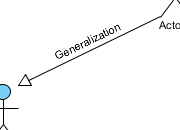 | | Definition | | A generalization is a taxonomic relationship between a more general classifier and a more specific classifier. Each instance of the specific classifier is also an indirect instance of the general classifier. Thus, the specific classifier inherits the features of the more general classifier. |
| | Properties | | | Name | The name of generalization. | | General | References the general classifier in the Generalization relationship. | | Specific | References the specializing classifier in the Generalization relationship. | | Visibility | Determines where the generalization relationship appears within different namespaces within the overall model, and its accessibility. | | Documentation | Description of generalization relationship. | | Substitutable | Indicates whether the specific classifier can be used wherever the general classifier can be used. If true, the execution traces of the specific classifier will be a superset of the execution traces of the general classifier. |
|
|
|
|
| |
LifeLine | |  | | Definition | | A lifeline represents an individual participant in the Interaction. |
| | Properties | | | Name | The name of lifeline. | | Base Classifier | A classifier is a classification of instances. | | Multiplicity | Specifies the allowable cardinalities for an instantiation of this lifeline. | | Documentation | Description of lifeline. | | Active | An active object is an object that, as a direct consequence of its creation, commences to execute its classifier behavior, and does not cease until either the complete behavior is executed or the object is terminated by some external object. | | Stopped | If a lifeline it stopped, this represents that the lifeline has received a destruction event. | | Multi-Object | A multiobject represents a set of lifeline instances. | | Attribute Links | A lifeline can be an instance that originates from a class. It is structured and behaves according to its class. An attribute link refers to an attribute, if any, defined in base classifier, with initial value specified. |
|
|
|
|
| |
LifeLine <<Boundary>> | |  | | Definition | | A lifeline represents an individual participant in the Interaction. |
| | Properties | | | Name | The name of lifeline. | | Base Classifier | A classifier is a classification of instances. | | Multiplicity | Specifies the allowable cardinalities for an instantiation of this lifeline. | | Documentation | Description of lifeline. | | Active | An active object is an object that, as a direct consequence of its creation, commences to execute its classifier behavior, and does not cease until either the complete behavior is executed or the object is terminated by some external object. | | Stopped | If a lifeline it stopped, this represents that the lifeline has received a destruction event. | | Multi-Object | A multiobject represents a set of lifeline instances. | | Attribute Links | A lifeline can be an instance that originates from a class. It is structured and behaves according to its class. An attribute link refers to an attribute, if any, defined in base classifier, with initial value specified. |
|
|
|
|
| |
LifeLine <<Control>> | |  | | Definition | | A lifeline represents an individual participant in the Interaction. |
| | Properties | | | Name | The name of lifeline. | | Base Classifier | A classifier is a classification of instances. | | Multiplicity | Specifies the allowable cardinalities for an instantiation of this lifeline. | | Documentation | Description of lifeline. | | Active | An active object is an object that, as a direct consequence of its creation, commences to execute its classifier behavior, and does not cease until either the complete behavior is executed or the object is terminated by some external object. | | Stopped | If a lifeline it stopped, this represents that the lifeline has received a destruction event. | | Multi-Object | A multiobject represents a set of lifeline instances. | | Attribute Links | A lifeline can be an instance that originates from a class. It is structured and behaves according to its class. An attribute link refers to an attribute, if any, defined in base classifier, with initial value specified. |
|
|
|
|
| |
LifeLine <<Entity>> | |  | | Definition | | A lifeline represents an individual participant in the Interaction. |
| | Properties | | | Name | The name of lifeline. | | Base Classifier | A classifier is a classification of instances. | | Multiplicity | Specifies the allowable cardinalities for an instantiation of this lifeline. | | Documentation | Description of lifeline. | | Active | An active object is an object that, as a direct consequence of its creation, commences to execute its classifier behavior, and does not cease until either the complete behavior is executed or the object is terminated by some external object. | | Stopped | If a lifeline it stopped, this represents that the lifeline has received a destruction event. | | Multi-Object | A multiobject represents a set of lifeline instances. | | Attribute Links | A lifeline can be an instance that originates from a class. It is structured and behaves according to its class. An attribute link refers to an attribute, if any, defined in base classifier, with initial value specified. |
|
|
|
|
| |
Link | |  | | Definition | | An association declares that there can be links between instances of the associated types. A link is a tuple with one value for each end of the association, where each value is an instance of the type of the end. |
| | Properties | | | Name | | | From | | | To | | | Specification | | | Classifiers | | | Slots | | | Documentation | |
|
|
|
|
| |
Message | | 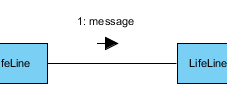 | | Definition | | A message defines a particular communication between Lifelines of an Interaction. |
| | Properties | | | Name | The name of message. | | Action Type | Type action type of the message. | | Return Value | The information to return to caller. | | Sequence No. | The number of message indicates the order of message within an interaction. | | Documentation | Description of message. | | Asynchronous | Determines whether the message is an asynchronous or a synchronous message. |
| | |
|
|
|
| |
Note | |  | | Definition | | A note (comment) gives the ability to attach various remarks to elements. A comment carries no semantic force, but may contain information that is useful to a modeler. |
| | Properties | | | Name | The name of note. | | Documentation | Specifies a string that is the comment. |
|
|
|
|
| |
Return Message | | 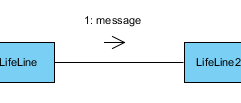 | | Definition | A message defines a particular communication between Lifelines of an Interaction.
Return message is a kind of message that represents the pass of information back to the caller of a corresponded former message. |
| | Properties | | | Name | The name of message. | | Action Type | Type action type of the message. | | Return Value | The information to return to caller. | | Sequence No. | The number of message indicates the order of message within an interaction. | | Documentation | Description of message. | | Asynchronous | Determines whether the message is an asynchronous or a synchronous message. |
|
|
|
|
| |
Send Message | | 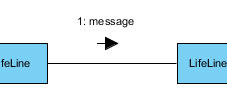 | | Definition | A message defines a particular communication between Lifelines of an Interaction.
Send message is a kind of message that represents the start of execution. |
| | Properties | | | Name | The name of message. | | Action Type | Type action type of the message. | | Return Value | The information to return to caller. | | Sequence No. | The number of message indicates the order of message within an interaction. | | Documentation | Description of message. | | Asynchronous | Determines whether the message is an asynchronous or a synchronous message. |
|
|
|
|
| |
Sequence Message | | 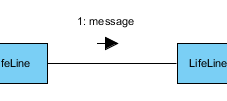 | | Definition | A message defines a particular communication between Lifelines of an Interaction.
Sequence message is a kind of message that represents the need of performing actions in sequence. |
| | Properties | | | Name | The name of message. | | Action Type | Type action type of the message. | | Return Value | The information to return to caller. | | Sequence No. | The number of message indicates the order of message within an interaction. | | Documentation | Description of message. | | Asynchronous | Determines whether the message is an asynchronous or a synchronous message. |
|
|
|
|
| |
Swimlane | | 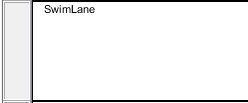 | | Definition | | Swimlane is used for partitioning the children in an communication diagram. Each swimlane represents a role. |
| | Properties | | | Name | The name of swimlane. | | Diagram name | The name of diagram. | | Documentation | Description of swimlane. |
|
|
|
|
| |
| Definition of notations is quoted from Object Management Group Unified Modeling Language (OMG UML) Superstructure Version 2.2 and former versions (for notations that do not exist anymore in latest specification). |
| |
|
Use case diagram
|
Class diagram
|
Sequence diagram
|
Communication diagram
|
State machine diagram
|
Activity diagram
|
Component diagram
|
Deployment diagram
|
Package diagram
|
Object diagram
|
Composite structure diagram
|
Timing diagram
|
Interaction overview diagram
|



